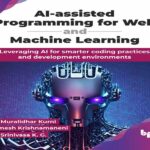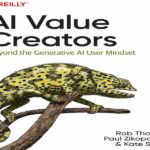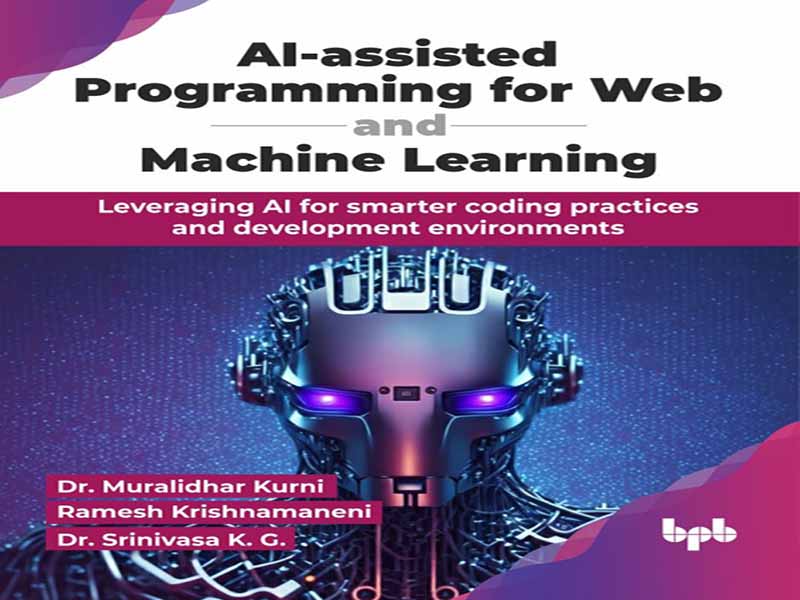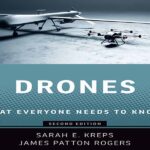- عنوان کتاب: AI-assisted Programming for Web and Machine Learning
- نویسنده: Dr. Muralidhar Kurni
- حوزه: کاربرد هوش مصنوعی در برنامهنویسی
- سال انتشار: 2026
- تعداد صفحه: 297
- زبان اصلی: انگلیسی
- نوع فایل: pdf
- حجم فایل: 7.74 مگابایت
توسعه نرمافزار وارد دوران جدیدی میشود. چیزی که زمانی تنها قلمرو کدنویسان انسانی بود، اکنون به فضایی مشارکتی تبدیل شده است که در آن هوش مصنوعی (AI) در کنار ما کار میکند، بهبودهایی را پیشنهاد میدهد، کد تولید میکند، خطاها را میگیرد و حتی قبل از اجرای راهحلها توسط ما، آنها را بهینهسازی میکند. وقتی برای اولین بار کدنویسی با کمک هوش مصنوعی را بررسی کردیم، هر یک از ما با ترکیبی سالم از کنجکاوی و شک و تردید به آن نزدیک شدیم. آیا یک هوش مصنوعی واقعاً میتواند پیچیدگیها و ظرافتهای گردشهای کاری توسعه مدرن را درک کند؟ ما آن را آزمایش کردیم و طی چند روز، شک و تردیدهای اولیه ما جای خود را به هیجان داد. ابزارهایی مانند GitHub Copilot و ChatGPT نه تنها وظایف تکراری کدنویسی را خودکار میکردند، بلکه راهحلهای زیبایی را پیشنهاد میدادند و رویکردهای نوآورانهای را معرفی میکردند که هیچکدام از ما پیشبینی نکرده بودیم. تجربه این امر به طور جمعی، نحوه تفکر ما در مورد برنامهنویسی را تغییر داد. ما متوجه شدیم که هوش مصنوعی اینجا نیست تا جایگزین خلاقیت یا تخصص یک توسعهدهنده شود – بلکه اینجاست تا آنها را تقویت کند. این کتاب از آن کشف مشترک متولد شده است و هدف ما این است که به شما کمک کنیم هوش مصنوعی را به عنوان یک شریک قابل اعتماد در سفر توسعه خود تجربه کنید. «برنامهنویسی با کمک هوش مصنوعی برای وب و یادگیری ماشین» راهنمای کامل و عملی شما برای ادغام هوش مصنوعی در تمرین کدنویسی روزانهتان است. ما با مبانی شروع خواهیم کرد – درک نقش هوش مصنوعی در برنامهنویسی، راهاندازی یک محیط آماده برای هوش مصنوعی و تسلط بر هنر مهندسی سریع. سپس به کاربردهای عملی خواهیم پرداخت: استفاده از هوش مصنوعی برای تسریع توسعه front-end و back-end، بهبود اشکالزدایی و بهینهسازی، و سادهسازی خطوط لوله یادگیری ماشین از پیشپردازش تا استقرار. همچنین مطالعات موردی دنیای واقعی، بهترین شیوهها و ملاحظات اخلاقی را برای مسئولیتپذیر و آماده نگه داشتن کار خود برای آینده خواهید یافت. چه دانشجویی باشید که برای اولین بار کدنویسی با کمک هوش مصنوعی را بررسی میکند، چه توسعهدهندهای که به دنبال کوتاه کردن جدول زمانی تحویل است، یا یک متخصص یادگیری ماشین که قصد دارد گردشهای کاری پیچیده را خودکار کند، این کتاب هم مهارتها و هم اعتماد به نفس لازم برای کار با هوش مصنوعی را به شما میدهد، نه به عنوان یک ترفند، بلکه به عنوان یک بخش ضروری از جعبه ابزار شما. در فصل آخر، هوش مصنوعی دیگر مانند یک چیز اضافی که گاهی اوقات امتحان میکنید، نخواهد بود – مانند یک همتیمی قابل اعتماد خواهد بود که نمیتوانید کار کردن بدون آن را تصور کنید. فصل 1: هوش مصنوعی در برنامهنویسی – سفر هوش مصنوعی را از آزمایشگاههای تحقیقاتی تا میزهای کدنویسی روزمره دنبال کنید. نقاط عطف تحولآفرین، از اولین آزمایشهای کمک به کد تا ابزارهای پیشرفته امروزی را بررسی کنید و ببینید که چگونه GitHub Copilot و ChatGPT در حال تغییر شکل گردشهای کاری توسعهدهندگان هستند. بیاموزید که چرا پذیرش در حال رشد است، چه مزایایی از گزارشهای پذیرندگان اولیه حاصل میشود و محدودیتهای هنوز در کجا قرار دارند تا بتوانید انتظارات واقعبینانهای برای هوش مصنوعی در کار خود تعیین کنید. فصل 2: راهاندازی محیط هوش مصنوعی شما – نتایج عالی با محیط مناسب شروع میشوند. بیاموزید که چگونه Visual Studio Code را برای ادغام هوش مصنوعی پیکربندی کنید، از Jupyter Notebook برای پروژههای دادهمحور استفاده کنید و کدنویسی مشارکتی را با GitHub مدیریت کنید. دریابید که چگونه Docker از گردشهای کاری کانتینری پشتیبانی میکند و چگونه عوامل هوش مصنوعی میتوانند وظایف روتین مانند آزمایش، استقرار و اصلاح کد را خودکار کنند و شما را آزاد بگذارند تا روی حل مسئله تمرکز کنید. فصل 3: مهندسی سریع – تفاوت بین نتایج متوسط و برجسته هوش مصنوعی اغلب به سرعت بستگی دارد. این فصل به شما نشان میدهد که چگونه میتوانید دستورالعملهای واضح و غنی از متن را برای نتایج خاص ایجاد کنید – چه ایجاد ویژگیهای کامل، تشخیص خطاها یا ساخت گردشهای کاری پیچیده ML. مثالهای دنیای واقعی نشان میدهند که چگونه تغییرات ظریف در عبارتبندی میتواند نتایج بسیار متفاوتی ایجاد کند و مطالعات موردی، استراتژیهای سریع مورد استفاده در پروژههای موفق را آشکار میکنند. فصل 4: هوش مصنوعی در توسعه فرانتاند – افزایش سرعت تولید طرحبندیهای HTML/CSS تمیز و واکنشگرا توسط هوش مصنوعی، سادهسازی توابع جاوا اسکریپت و مفاهیم UI/UX نمونه اولیه را در عرض چند دقیقه تجربه کنید. ببینید چگونه نمونهسازی سریع هوش مصنوعی را با تخصص طراحی خود ترکیب کنید تا نتایج را به دقت تنظیم کنید و این قابلیتها را با React ادغام کنید تا برنامههای فرانتاند پویا، دادهمحور و قابل دسترس ارائه دهید. فصل 5: هوش مصنوعی برای توسعه بکاند – بیاموزید که چگونه هوش مصنوعی میتواند با تولید نقاط پایانی API، پیشنهاد پرسوجوهای پایگاه داده بهینه و حتی نوشتن منطق احراز هویت، کدنویسی سمت سرور را تسریع کند. مثالهایی را با استفاده از Node.js و Django، با راهنمایی در مورد تضمین امنیت، مقیاسپذیری و قابلیت نگهداری، بررسی کنید. همچنین خواهید دید که چگونه هوش مصنوعی میتواند به مستندسازی و آزمایش خودکار برای پشتیبانی از سلامت بلندمدت بکاند کمک کند. فصل 6: اشکالزدایی و بهینهسازی با هوش مصنوعی – اشکالزدایی را از یک کار طاقتفرسا و زمانبر به یک فرآیند کارآمد و مشارکتی تبدیل کنید. یاد بگیرید که چگونه پیامهای خطای هوش مصنوعی را دریافت کرده و پیشنهادهای عملی دریافت کنید، گلوگاههای عملکرد پنهان را شناسایی کنید و کد را برای سرعت و مقیاسپذیری بهینه کنید. این فصل همچنین ادغام هوش مصنوعی با ابزارهای پروفایلینگ را برای نظارت بر عملکرد در زمان واقعی پوشش میدهد. فصل 7: پیشپردازش دادهها با هوش مصنوعی – یادگیری ماشین به دادههای با کیفیت بالا بستگی دارد. در اینجا، یاد خواهید گرفت که چگونه هوش مصنوعی میتواند مجموعه دادهها را تمیز کند، مقادیر گمشده را مدیریت کند، قالبها را عادیسازی کند و ویژگیهای کلیدی را به طور خودکار استخراج کند…
Software development is entering a new era. What was once the sole domain of human coders is now a collaborative space where artificial intelligence (AI) works alongside us, suggesting improvements, generating code, catching errors, and even optimizing solutions before we run them. When we first explored AI-assisted coding, each of us approached it with a healthy mix of curiosity and skepticism. Could an AI truly understand the complexities and nuances of modern development workflows? We put it to the test, and within days, our initial doubts gave way to excitement. Tools like GitHub Copilot and ChatGPT were not only automating repetitive coding tasks but also suggesting elegant solutions and introducing innovative approaches none of us had anticipated. Experiencing this collectively changed the way we thought about programming. We realized that AI is not here to replace a developer’s creativity or expertise — it is here to amplify them. This book was born from that shared discovery, and we aim to help you experience AI as a trusted partner in your development journey. AI-assisted Programming for Web and Machine Learning is your complete, hands-on guide to integrating AI into your daily coding practice. We will start with the foundations — understanding AI’s role in programming, setting up an AIready environment, and mastering the art of prompt engineering. Then we will move into practical applications: using AI to accelerate front end and back end development, enhance debugging and optimization, and streamline machine learning pipelines from preprocessing to deployment. You will also find real-world case studies, best practices, and ethical considerations to keep your work responsible and future-ready. Whether you are a student exploring AI-assisted coding for the first time, a developer looking to shorten delivery timelines, or a machine learning practitioner aiming to automate complex workflows, this book will give you both the skills and the confidence to work with AI, not as a gimmick, but as an essential part of your toolkit. By the final chapter, AI will not feel like an extra you occasionally try — it will feel like a trusted teammate you cannot imagine working without. Chapter 1: AI in Programming – Trace AI’s journey from research labs to everyday coding desks. Explore transformative milestones, from the first code-assist experiments to today’s advanced tools, and see how GitHub Copilot and ChatGPT are reshaping developer workflows. Learn why adoption is growing, what benefits early adopters report, and where the limitations still lie so you can set realistic expectations for AI in your work. Chapter 2: Setting up Your AI Environment – Great results start with the right environment. Learn how to configure Visual Studio Code for AI integration, use Jupyter Notebook for data-driven projects, and manage collaborative coding with GitHub. Discover how Docker supports containerized workflows and how AI agents can automate routine tasks like testing, deployment, and code refactoring, leaving you free to focus on problem-solving. Chapter 3: Prompt Engineering – The difference between mediocre and outstanding AI results often comes down to the prompt. This chapter shows you how to craft clear, context-rich prompts for specific outcomes—whether generating full features, diagnosing errors, or building complex ML workflows. Real-world examples demonstrate how subtle changes in phrasing can produce dramatically different results, and case studies reveal prompt strategies used in successful projects. Chapter 4: AI in Front end Development – Experience the speed boost of letting AI generate clean, responsive HTML/CSS layouts, streamline JavaScript functions, and prototype UI/UX concepts in minutes. See how to combine AI’s rapid prototyping with your design expertise to finetune results and integrate these capabilities with React to deliver dynamic, data-driven, and accessible front end applications. Chapter 5: AI for Back end Development – Learn how AI can accelerate server-side coding by generating API endpoints, suggesting optimized database queries, and even writing authentication logic. Explore examples using Node.js and Django, with guidance on ensuring security, scalability, and maintainability. You will also see how AI can help with documentation and automated testing to support long-term back end health. Chapter 6: Debugging and Optimization with AI – Transform debugging from a time-consuming chore into an efficient, collaborative process. Learn how to feed AI error messages and receive actionable suggestions, detect hidden performance bottlenecks, and optimize code for speed and scalability. This chapter also covers integrating AI with profiling tools to monitor performance in real time. Chapter 7: Data Preprocessing with AI – Machine learning depends on high-quality data. Here, you will learn how AI can clean datasets, handle missing values, normalize formats, and extract key features automatically. Explore techniques for visualizing complex data relationships and preparing both structured and unstructured data for analysis, saving hours of manual preprocessing. Chapter 8: Building and Training Machine Learning Models – Use AI to assist in selecting the right algorithms, setting up your ML pipeline, and training models efficiently. Build classification, regression, CNN, and MLP models while learning how to fine-tune hyperparameters for maximum performance. Understand evaluation metrics in depth so you can measure success beyond just accuracy. Chapter 9: Deploying Optimized ML Models – A trained model is only valuable when it is in use. This chapter shows you AI-assisted approaches for fine-tuning, versioning, and deploying models to production. Learn scalable deployment strategies, from containerized services to cloud-based hosting, and see how to automate updates and monitor model performance post-deployment. Chapter 10: Real-world Applications – Go behind the scenes of AI-assisted projects in full-stack web development and machine learning. Learn how teams cut development time, improve code quality, and deliver innovative solutions using AI tools. Each case study includes takeaways you can apply to your work, plus cautions to help you avoid common pitfalls. Chapter 11: Future Innovations and Ethics in AI – Look beyond current capabilities to emerging trends like autonomous coding agents, multimodal AI assistants, and integrated AI project management. At the same time, address ethical challenges: mitigating bias, safeguarding user privacy, and ensuring that automation supports — rather than replaces — human creativity.
این کتاب را میتوانید از لینک زیر بصورت رایگان دانلود کنید:
Download: AI-assisted Programming for Web and Machine Learning




































نظرات کاربران